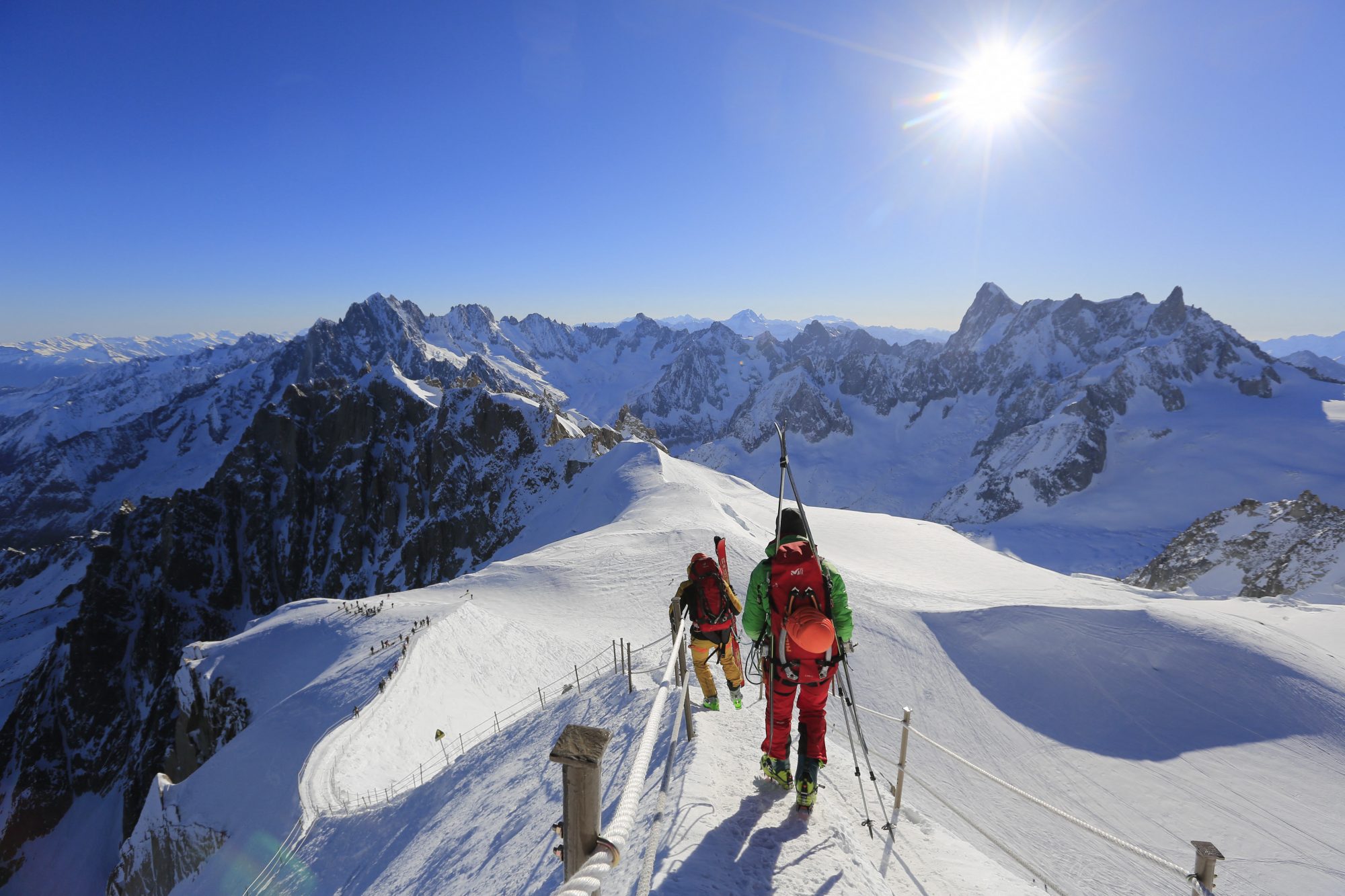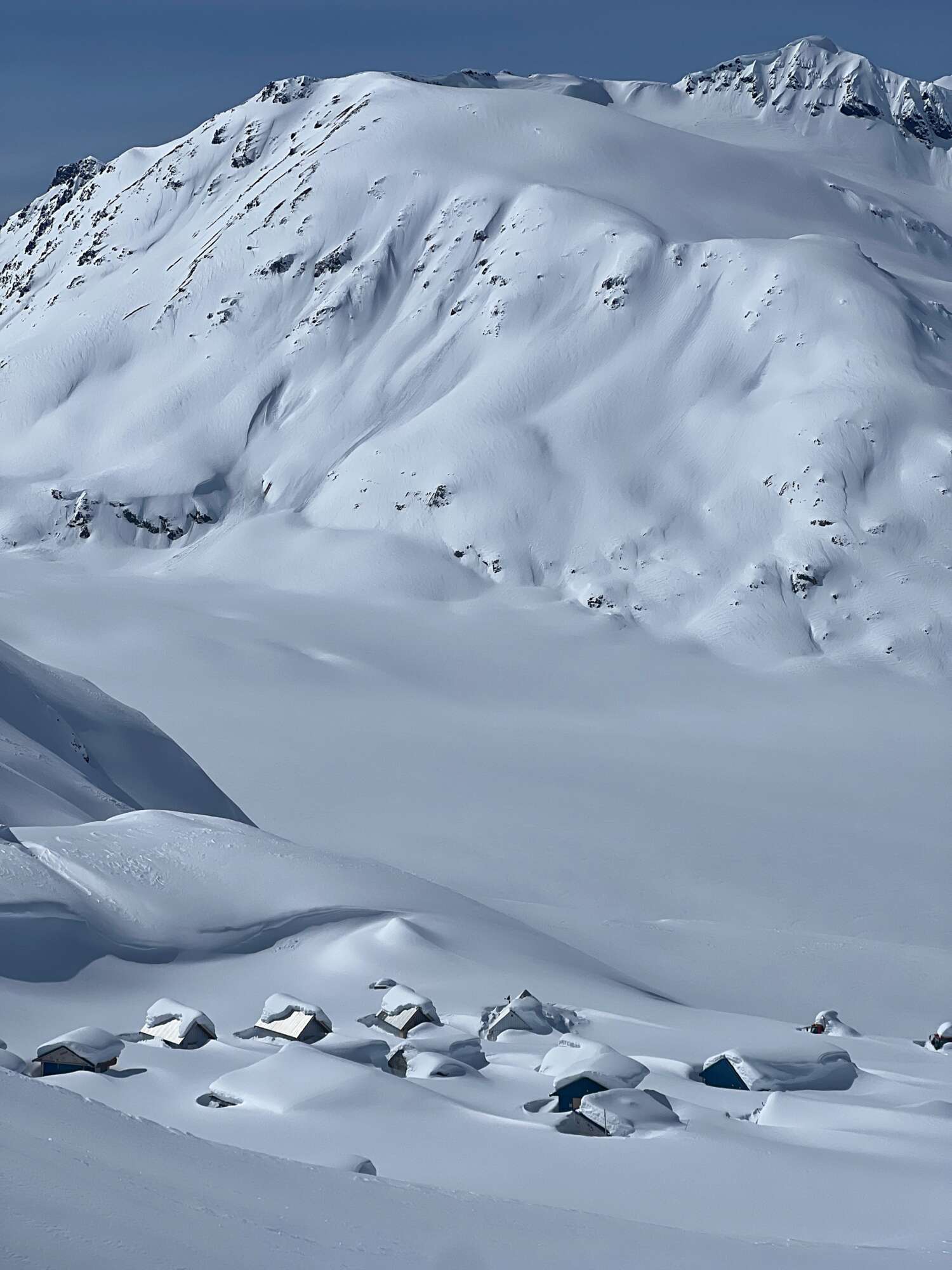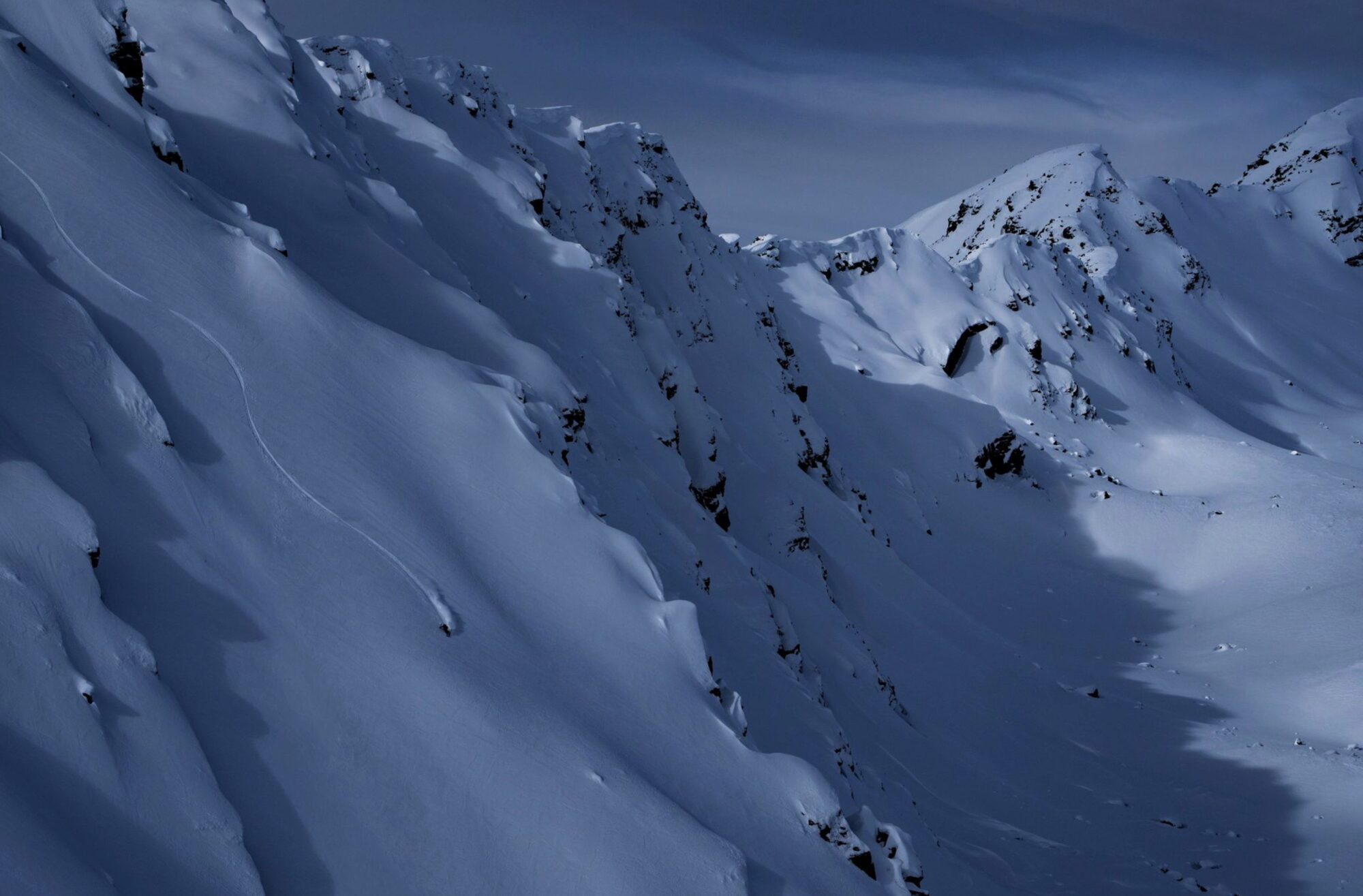Following my trip to Saint-Gervais in January, I thought I’d check out its next-door neighbour, Chamonix Mont-Blanc, and the legendary Vallée Blanche.
Chamonix is one of the most iconic ski resorts in the world. Host to the first Winter Olympic Games in 1924 and a key stage in the FIS Alpine Ski World Cup today, its ski and snowboard credentials are self-evident. However, Chamonix is more than just its winter sports: as my guide Damien would later tell me, Chamonix is the “ultimate mountaineering town”—now even more popular in summer than winter.
Nonetheless, I was there for the resort’s 155+ km of pisted slopes, plus the serious off-piste of the Vallée Blanche. While I arrived to drizzle that I must’ve brought in the car ride from Alsace, an overnight cold snap and powder dump made for excellent conditions.

Arriving & accommodation in Chamonix
As one of the largest ski towns in the Alps with upwards of 60,000 visitors a day in winter, Chamonix has incredible variety in terms of accommodation. I was lucky to stay at Chalet Ski Breezy on the west side of town, close to the Mont-Blanc Tunnel. Its cosy, cinnamon-coloured rooms come at a competitive price, with full catering provided by the affectionate English hosts. After three hard days in sun and snow, Ski Breezy’s comfy armchairs, complimentary espressos, and massive bookshelf of mountain literature were the perfect reward.
Before hitting the slopes, I headed to Chamonix’s Tourism Office in the town centre. There, the ever-friendly team helped me organise my guide for the Vallée Blanche, providing me with a complimentary ski map and a limited-edition Mont Blanc Buff available from the boutique. With a caring smile, press officer Nathalie told me that first-time visitors to the area should always get a guide if going off-piste. This is not only for safety’s sake but also, as I discovered, the best way to explore the domain.
My final task was to pick up my skis and boots. For this, I headed to Skiset Chamonix, located right beside the Aiguille du Midi cable car leading up to the Vallée Blanche. Skiset never fails to offer fantastic service at a good value, with friendly, well-spoken staff catering to your every need. On entering, I saw that their Chamonix shop had a large selection of blackcrows—Chamonix’s local ski and the favourite of big mountain and freeriders. Having checked the powder-heavy forecast, I picked a pair for myself and prepared for my first day on the slopes the next morning.


Chamonix GrandsMontets CREDIT Chamonix Tourist Office & Monica Dalmasso
Day 1: Grands Montets
Owing to its size, Chamonix-Mont Blanc comprises several different, unconnected ski areas within the Arve Valley. For this reason, it’s still a popular car resort. However, the town also has a free, regular shuttle service visitors are encouraged to take, and it is easily accessible by rail via Geneva thanks to the station in the centre of town.
On day one, I headed up-valley to the village of Argentière (1,252m), a 15-minute drive from Chamonix’s town centre. Argentière forms the base camp for the Grands Montets area, the highest lift-accessible summit of which is Bochard, at 2,765m. If you’re a tourer and visiting in March, be sure to check out the Trace des Grands—a mass ski touring/mountaineering event with races to the foot of the Aiguille Verte (4,121m).
At 2,000m, the snow’s a guarantee, but it was the cloud cover I’d have to contend with on my first morning. A few hundred metres above the Plan Joran gondola’s busy base, the sugar-coated forests surrounding Argentière became thick mist.
For the first few hours at Grands Montets, visibility was middling—a regrettable reality of almost every ski trip. However, sticking to the lower slopes within the treeline, I was able to practise my carving and enjoy the fresh snow, picking up some speed on the joyous Pierre à Ric red.
After a few shuttle runs, I made my way across the mountain towards the Combe de la Pendant bowl, stopping at a wee café at the base of the Retour Pendant chair to refuel with a much-needed hot chocolate. Around then, as if by miracle, the clouds began to lift. Taking the chair back up, I saw some excellent opportunities for tree skiing between the Remuaz black (which was, that day, a heavy mogul run) and the lower section of the Chamois.
From the top of Retour Pendant, I took the gentle Marmottons blue down to the Herse gondola. With visibility restored, the once choppy slopes seemed as smooth as first tracks. From said gondola I had a full view of the the Aiguille Rouges massif dead ahead, and at the top disembarked to blue skies and sunshine. Like the Pierre à Ric, Les Combes was a red run worthy of doing again and again, with plenty of gullies and couloirs beside it, perfect for freeriding.
Around two, it was time for lunch. Instead of dining on the mountain, I took the dedicated ski touring track down from Lognan (1,972m) to the sunny terrace of L’Argentero, a short walk from the Plan Joran gondola. Their gorgeous fig and goat cheese croute (followed by a double espresso) gave me the strength to reascend for my last few runs, a light wind now blowing the powder off the fir trees, sparkling in the sun.
Under dazzling bluebird skies, it was time to try the snow at Bochard, reached via the Bochard gondola. Before descending, I peeked down the infamous Poubelle Couloir at the top of the lift—chained up on account of the prior day’s conditions. Thanking my lucky stars to be on the well-trodden path, I turned away and took the magnificent Bochard red back to Lognan instead, gulping the Alpine air like spring water.
After a speedy final descent of Pierre à Ric, I arrived back in Argentière just as the sun disappeared behind the Aiguilles Rouge; the Aiguille du Midi opposite, and beyond that, Mont Blanc, now caught in its last few rays, as if lit with a halo. Legs aching, the ride back to town was glorious.

Dining out in Chamonix-Mont Blanc
Having worked in Chamonix for over 24 years, my hosts at Ski Breezy were kind enough to recommend several great locations for dining and drinking out.
First, and most importantly, drinks: if you’re looking for a more refined après-ski, the restaurant bars along the tiny Rue des Moulins are worth checking out. On the other hand, Chamonix has its own Folie Douce located in town (Club 1969) and open until 1 am. As I arrived amidst the Six Nations, my hosts informed me that Le Privilège Tapas Bar is the best place to watch the rugby (and soak up some live music), and for good, local craft beer, the Big Mountain Brewing Co. is a must-visit.
For food, I was fortunate to sample several locations, beginning with the trendy Le Boccalatte, whose gorgeous fondue aux cèpes paired perfectly with the house Chambord cocktail. Right next door, on my final night, I went to the much quirkier La Poêle—the house of a thousand omelettes—perfect for lovers of all things chicken (as it turned out, I got the delectable truffle penne).
I also visited the ever-chic PlanB, having sampled its sister restaurant in Saint-Gervais. As a hotel and restaurant, it’s a popular choice for families, with a massive games area beside the open-planning dining hall and popular film posters lining the walls, as well as some decent veggie options (try the blooming onion—you won’t regret it).

Day 2: La Vallée Blanche
Beginning at the Aiguille du Midi (3,842m), La Vallée Blanche is one of the highest accessible lift-accessible ski areas in the Alps, owing to the historic Aigulle du Midi cable car (opened 1954).
Apart from needing to ski it with a fully qualified high mountain guide, you can also find lots of pre-descent advice at Chamonix’s High Mountain Information Office, (La Chamoniarde), an important meeting place for skiers, mountaineers, hikers, hut keepers, mountain guides and the place to visit before heading out into the mountains. The team of professionals there welcomes, informs, and provides free advice to all mountain enthusiasts, from beginners to experienced alpinists.
On my second day in Chamonix, I arrived at the cable car base station with trepidation. My amicable guide, Damien, was part of the Compagnie des Guides de Chamonix—the oldest and largest mountain guide association in the world. He proved essential in what turned out to be the most difficult leg: the lift queue. Because of the weather earlier that week, it was the first day the cable car had opened. It was also a Saturday; hence, there was something of a scrum in downtown Chamonix.
Nonetheless, we got on peaceably enough, and it was in the queue that I realised many of the cable car-users were not skiers but sightseers. On reaching the top, I realised why: the panorama from the Aiguille du Midi’s top station is, literally and figuratively, breathtaking. The extended complex and surrounding terrace at the cable car’s top give you views of all the Alps’ big hitters: the Matterhorn, Lac Léman, Geneva, the Jura Range, Monte Rosa, and of course, Mont Blanc.
Indeed, Mont Blanc is so close by, only 1,000m more in elevation, that it appears more like a gentle hill than the colossus it is. Damien pointed out the various stopping points on its shoulder, as well as the iconic Refuge du Goûter, hidden just behind the final ridge. He also led me to the Pas Dans Le Vide: a suspended glass box, opened 2013, which provides the perfect photo opportunity for those wishing to walk on wind.


Vallée Blanche ©OT Chamonix
However, for freeriders, it’s the view into La Vallée Blanche that makes it worth the trip: not merely a bowl, but a crystal cornucopia. Donning crampons and a safety harness, Damien and I exited the Aiguille du Midi through an icy tunnel, arriving on a steep and narrow arête. Several times, I had to stop my gaze from falling into the winter wonderland on our right to make sure I didn’t lose my footing.
As I swapped my crampons for skis, I also had to discard my jumper—the sun was beating down, and a patch of windblown snow at the valley’s top would make our first descent tricky. Nonetheless, those first sweeping turns were pure bliss, and judging by the sounds of nearby skiers, the feeling was mutual.
From Chamonix, La Vallée Blanche has several possible routes, also linking up with skiers from Courmayeur on the far-side. Damien led us down the “Vrai Vallée” route (with the alternatives being the gentler Classical Route, and for the more adventurous, the Moyen and Grand Envers), on the way pointing out several landmarks. Looking back after a few hundred metres descent, I saw the ochre southern face of the Aiguille du Midi—a crack-climbing paradise in summer—as well as some of the couloirs Glen Plake shredded in the 2010s. Seeing them in person, I realised his pluck lived up to the haircut.
Further down, two feet deep in powder, we passed between the mint ice cream of La Vallée Blanche’s titular glacier on our left, and the Glacier de Géants on our right. In the distance, over the brow of the latter, I could see the Refuge du Requin perched on a cliff edge. Reaching it required a careful traverse, impossible in poor snow conditions.
Nonetheless, the extra effort was worth it: we arrived at perhaps the most spectacular sun terrace in Savoy, enjoying an ice-cold IPA 2,516m up. With shades and suncream on, I eyed up other guests’ tartiflettes, as well as the rock climbing trails on the rear side of Grands Montets. Damien (a keen rock climber himself) informed me that if you’re on an expedition, the Refuge also offers bunks for the night—just be sure to book in advance.


Vallee Blanche Credit Chamonix Mont Blanc Tourist Office and Eric Berger
The descent from the Refuge made me wish I’d done more leg days over winter. Nonetheless, we reached “The Lunchroom” at a decent speed; so-called because it was a popular group picnic spot before guides discovered dangerous crevasses. From here, the vast, flat Mer de Glace fills your vision: a backcountry canvas between glacial ice and rocky crags.
However, the Mer is much more than La Vallée Blanche’s flat section. It’s perhaps the starkest reminder of the threat facing all ski resorts: climate change. What was once within reach of the Glacier de Géants is now a white wasteland—with the vast majority of glacier retreat occurring in the past forty years. Damien showed me the point on the valley’s hillsides that the glacier once reached and informed me that by current projections, the Mer de Glace will be a lake by 2050. Where once it was possible to ski all the way to Chamonix, today, it is an arduous task achievable only after the heaviest of snowfall.
In a time of climate change deniers, some of whom occupy positions of immense power, La Vallée Blanche is Chamonix’s res ipsa loquitu: both an incredible ski run and a poignant lesson in ecology. Fortunately, Chamonix-Mont Blanc has been taking steps to mitigate its environmental footprint, which you can read about here. Whether the glaciers will continue to exist in a century’s time goes beyond the resort, however: it’s the responsibility of policymakers, corporations, and consumers the world over.
Without distracting from the above, the final section of La Vallée Blanche involved a virtual bobsled run through the Canyon de Glace. A fast-flowing river in summer, in winter, the Canyon de Glace is a popular ice-climbing destination within a gallery of giant icicles. After leaving the Canyon, all that’s left is a rocky snowfield in the shadow of the Aiguille du Grépon.
With tired legs and aching lungs, former skiers of La Vallée Blanche might recall the infamous 600+ metal steps leading up to the Gare du Montenvers that awaited them at the end. Thankfully, that punishment is no more, as exactly one year ago, Chamonix-Mont Blanc opened the Télécabine de la Mer de Glace. Now, the journey from the slopes to the train ride home is an easy five-minute affair (and for that reason, expect a fair few sightseers frolicking in the snow).
While famished skiers can revive themselves in the Gare du Montenvers’ restaurant, it’s best to get to the station platform ASAP as big queues can form—just be sure to pick up a souvenir from the gift shop on your way there.


Balme
Day 3: Domaine de Balme
Before departing Chamonix-Mont Blanc for my flight back to Scotland, I managed to squeeze in one more morning’s skiing at the Domaine de Balme, just a little further up the road from Grands Montets. If you’re taking the car to Le Tour (one of Domaine de Balme’s two basecamps), I’d highly recommend an early start: as the first day of the French and English half-term, parking became an expert level of Tetris after 9 am.
Nonetheless, I managed to board the Charamillon gondola and was rewarded with a stunning view of the Arve Valley, as well as the beginner slopes for which Le Tour is most popular. These slopes continue higher up, with several gentle blues that are perfect for practising on, serviced by a network of pomas.
Compared to Grands Montets, the Domaine de Balme is a wider, flatter area with less tree-skiing and more traditional, rolling pistes. The short and sweet Aiguillette red was a personal favourite, as like Les Combes a few days before, I found myself doing breakneck shuttle runs (with a hot chocolate at Les Alpages de Balme when I needed a break).
That being said, on the other side of the mountain, there are a few nice tree runs, including the shaded Les Esserts blue and more exciting Belle Place red. If you fancy skiing down to Vallorcine for lunch, take the zig-zag Forêt Verte red as I did—but don’t make the mistake of not booking a restaurant ahead of time, especially during half-term. As the village’s main restaurant was full, I headed to a tiny mom-and-pop pasta stand, L’Ours, in the Vallorcine gondola’s carpark. Frankly, their box of takeaway Bolognese was enough to please my inner child (and was also the cheapest price I’ve seen on any mountain).
Returning via the Vallorcine gondola, I caught sight of the awesome Émosson Dam gleaming in the sunshine on my way back up. There was only time for a few more runs before I had to return my skis and depart Chamonix, the last of which was the by-now fairly slushy Les Caisets red, back to the carpark.
With shades on, under azure skies, and in full view of the almighty Mont Blanc, which had skewered a stack of discus-shaped clouds on its summit, I couldn’t think of a more perfect way to end my trip.




